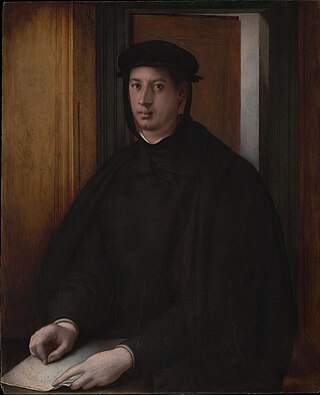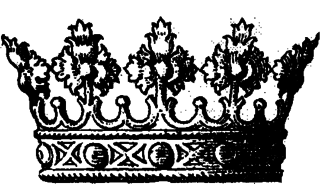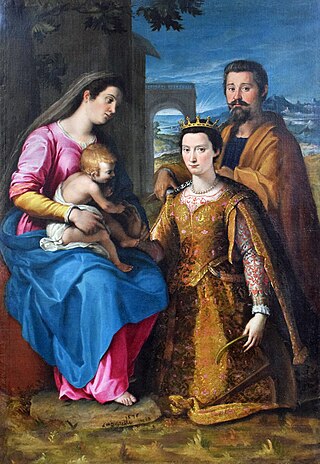
Bernadetto de' Medici (died after 1576) was an Italian patrician who moved from Florence to Naples and established the Ottaiano branch of Medici - one of two Medici branches still extant. [1]

Bernadetto de' Medici (died after 1576) was an Italian patrician who moved from Florence to Naples and established the Ottaiano branch of Medici - one of two Medici branches still extant. [1]
A member of a cadet branch of the Medici family (the one later called the Princes of Ottajano), he was the son of Ottaviano de' Medici and Francesca Salviati. In 1559, he married Giulia de' Medici, the illegitimate daughter of Duke Alessandro de' Medici by Taddea Malespina.
In 1567, he bought the seigniory of Ottaiano in the Kingdom of Naples from Cesare I Gonzaga and moved there, probably due to strife with Grand Duke Cosimo I. He died in Naples after 1576.
His son Alessandro (died 1606) was Lord of Ottaiano and General of the Papal States. His descendants unsuccessfully claimed the title of Grand Duke of Tuscany after the extinction of the main branch of the Medici family. [2]
Bernardetto married the illegitimate daughter of the Duke Alessandro de 'Medici, Giulia in 1559. It was her second marriage after the death of her first husband Francesco Cantelmi, Duke of Popoli. They had a son:
Alessandro († 1606). Lord of Ottaiano, general of the pontifical army since April 1605, governor of Borgo.

The House of Sforza was a ruling family of Renaissance Italy, based in Milan. Sforza rule began with the family's acquisition of the Duchy of Milan following the extinction of the Visconti family in the mid-15th century and ended with the death of the last member of the family's main branch, Francesco II Sforza, in 1535.

Pope Leo XI, born Alessandro Ottaviano de' Medici, was head of the Catholic Church and ruler of the Papal States from 1 April 1605 to his death, on 27 April 1605. His pontificate is one of the briefest in history, having lasted under a month. He was from the prominent House of Medici originating from Florence. Medici's mother opposed his entering the priesthood and sought to prevent it by having him given secular honours, but after her death he eventually was ordained a priest in 1567. In his career he served as Florence's ambassador to the pope, Bishop of Pistoia, Archbishop of Florence, Papal legate to France, and as the cardinal Prefect for the Congregation of Bishops and Regulars. He was elected to the papacy in the March 1605 papal conclave and served as pope for 27 days.

The House of Medici was an Italian banking family and political dynasty that first consolidated power in the Republic of Florence under Cosimo de' Medici during the first half of the 15th century. The family originated in the Mugello region of Tuscany, and prospered gradually until it was able to fund the Medici Bank. This bank was the largest in Europe during the 15th century and facilitated the Medicis' rise to political power in Florence, although they officially remained citizens rather than monarchs until the 16th century.

Cosimo I de' Medici was the second duke of Florence from 1537 until 1569, when he became the first grand duke of Tuscany, a title he held until his death.

Alessandro de' Medici, nicknamed "il Moro" due to his dark complexion, Duke of Penne and the first Duke of the Florentine Republic, was ruler of Florence from 1530 to his death in 1537. The first Medici to rule Florence as a hereditary monarch, Alessandro was also the last Medici from the senior line of the family to lead the city. His assassination at the hands of distant cousin Lorenzaccio caused the title of Duke to pass to Cosimo I de Medici, from the family's junior branch.

Giulia Romola di Alessandro de' Medici was the illegitimate, possibly multiracial, daughter of Alessandro de' Medici, Duke of Florence and his mistress Taddea Malaspina.

The Duchy of Parma and Piacenza was an Italian state created in 1545 and located in northern Italy, in the current region of Emilia-Romagna.

The Grand Duchy of Tuscany was an Italian monarchy that existed, with interruptions, from 1569 to 1860, replacing the Republic of Florence. The grand duchy's capital was Florence. In the 19th century the population of the Grand Duchy was about 1,815,000 inhabitants.

The Duca della Repubblica Fiorentina, rendered in English as Duke of the Florentine Republic or Duke of the Republic of Florence, was a title created in 1532 by Pope Clement VII for the Medici family, which ruled the Republic of Florence. There were effectively only two dukes of the Republic of Florence, Alessandro de' Medici and Cosimo de' Medici, the second duke being elevated to Grand Duke of Tuscany, causing the Florentine title to become subordinate to the greater Tuscan title.

Virginia de' Medici was an Italian princess, a member of the House of Medici and by marriage Duchess of Modena and Reggio.

Paolo Giordano Orsini was an Italian nobleman, and the first duke of Bracciano from 1560. He was a member of the Roman family of the Orsini.

Ottaviano de' Medici was an Italian politician. He was the ancestor of the Princes of Ottajano line of the Medici family.

Taddea Malaspina was an Italian noblewoman of the 16th century. A scion of the Massa branch of the ancient Malaspina family, she was the mistress of Alessandro de' Medici, Duke of Florence, from the early 1530s to about 1537 and was likely the mother of at least two of his children, Giulio and Giulia de' Medici. Giulio de' Medici was associated with the Malaspina family at different points throughout his life.

The Princes of Ottajano are a cadet branch of the ducal dynasty of Tuscany. Along with the Veronese Medici Counts of Caprara, and Gavardo, they make up the last and closest descendants to the main line of the House of Medici.

Alessandro Pieroni was an Italian architect and painter. He was active mainly in a Mannerist style, working for the courts of Grandukes Francesco I and Ferdinando I de' Medici, Grand Duke of Tuscany.

Bindo Altoviti of the Altoviti family was an Italian banker and one of the most influential papal bankers of his generation. A patron of the arts, he cultivated close friendships with artists such as Benvenuto Cellini, Raphael, Michelangelo and Giorgio Vasari.

Lucrezia Quistelli della Mirandola (1541–1594) was an Italian painter.
Alessandro de' Medici (1560–1606) was an Italian patrician, belonging to Neapolitan branch of House of Medici.
Giuseppe de 'Medici of Ottajano, Prince of Ottajano was an Italian noble and Sicilian politician from Naples.

Giulia da Varano, also known after her marriage as Giulia da Varano della Rovere, was an Italian noblewoman and member of the Da Varano family. She was the ruling Duchess of Camerino during 1527–1539 and by marriage Duchess of Urbino from 1534 until her death.